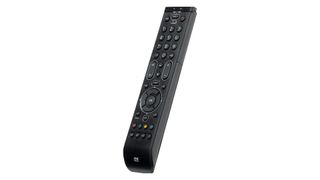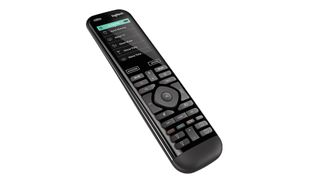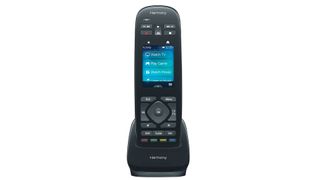But technology still can’t fix the problem of losing your TV remote. Move house and you’ll probably find a remote control you spent a whole weekend searching for that somehow found its way inside a sofa cushion. Anyone with a decent home AV setup, meanwhile, still has to deal with half a dozen of the things.
The best solution is a universal remote, which at least means there’s only one remote to keep tabs on. So let's take a look at exactly what today’s universal remotes can do, and how they work.
Most of you probably understand the basic concept of a universal remote already. It’s a remote control that can mimic the signals sent by the controller that came with your TV, your home cinema receiver and so on.
There are two main reasons to buy one: either you’ve lost an original remote, and don’t want to pay the often high cost of a direct replacement. Or you want to scale down the number of remotes littering your lounge.
Almost all universal remotes use IR, infrared. It’s the same spectrum used by single-device remotes.
If you buy a budget remote such as the One for All Essence, you’ll use a series of button presses to program the thing, finding the right set of commands for your equipment. Companies like Sony and Panasonic have only used a few different sets of commands over the last decade or so for most of their TVs. You simply cycle through them until you find the set that turns the box in question on and off.

Higher-end universal remotes have larger databases and companion apps that let you simply choose the devices you have on your phone. It’s quicker, easier, and simpler to add to should your setup change.
The more you spend, the more devices a universal remote tends to support. Logitech’s Harmony Elite supports 15 devices in the one remote, while baseline models like the One for All Simple only support one. Again, we’re getting back to the crucial use-case question: are you replacing a lost remote or looking to use just one controller instead of a whole bunch?

High-end universal remotes also allow you to set up macros, often called activities. This is where you’ll make a single button or touchscreen press fire off a bunch of commands.
One called 'Watch TV', for example, might turn on your Sky box, AVR and TV, switch the receiver to the right channel and set your TV to the correct HDMI input. Another favorite is to switch all your devices off with a single press.
There are two main universal remote controller brands, and they’re the ones we’ve mentioned so far. Logitech makes all the well-known higher-end models, in the shape of its Harmony series, while One for All is our top pick for more affordable handsets.

In the US you’ll also see a slew of low-price options from RCA. And if you’re buying for an elderly relative, or want an ultra-simple remote that just covers them TV basics, the Doro HandleEasy just lets you change channels and volume; it's been around for years, but it's a solid lo-fi gadget.
Some phones can also function as universal remotes, although perhaps not the models you might assume. They need to have a feature called an IR blaster, which enables them to transmit the same signals as a normal remote control.
These used to be reasonably common, but have become quite rare, with the feature regarded as unloved and generally unused in the phones that had it. Current phones with an IR blaster include the Honor 9 and Huawei P10 Plus. Some Xiaomi phones have one too. The common thread? These are Chinese companies.

The last high-profile phone to have an IR blaster was the LG G5, while the last flagship Samsungs with IR were the Galaxy S6 and S6 Edge back in 2015. These phones have apps that enable you to configure your own setup, with on-screen buttons for (almost) all your remotes’ functions.
We actually know people who owned phones with IR blasters a few years ago, but who ended up spending a significant amount of cash on a universal remote, oblivious to their phone’s abilities.
Have a phone with an IR blaster? You might want to check out a third-party remote control app like Peel or Sure, as these have a smarter interface than most built-in apps.
One weak point of the vast majority of universal remotes is that they can't control most smart home equipment, or Sony’s PS3 and PS4. This is because they use either Bluetooth, RF or Wi-Fi instead of infrared. The solution is a hub that supports these other standards, and right now you have two main choices.
Logitech offers the best-known, and best, one. The Logitech Home Hub works with Microsoft and Sony game consoles, and a wide variety of smart home gadgets including Philips Hue lights. It hooks onto your home Wi-Fi, and can be controlled either by a phone app or one of Logitech’s higher-end remotes.

Using one of the Harmony series’ tasty macro activities, you could therefore set the lighting level for movie night, as well as turning on your AV setup, with a single press.
Elsewhere, the Broadlink RM and RM Pro are hubs that can control IR and RF (Pro model) devices through a mobile phone app. They're significantly cheaper than the Logitech Home Hub, although as they don't use Bluetooth you can’t use them to control a Sony PS4.
It is a low-cost way to make up for the lack of an IR blaster, though.
One additional benefit of the Logitech Home Hub system is that you can already control it through Amazon’s digital assistant Alexa.
If you have an Amazon Echo or Echo Dot you can add a Harmony ‘skill’ to it, and using this you can say “Alexa, tell Harmony to turn on the TV”, and it’ll do so. We’ve tried it out as part of our research for this guide, and it works rather well.

One day we'll be able to control everything over Wi-Fi, but until that day it's reassuring to see that universal remotes aren’t content to become ‘retro’ gadgets; they’re keeping up with the times.
As the Logitech Harmony series is easily the most important range of universal remotes for people looking for an experience to suit a high-end setup, let’s take a quick look at what’s on offer.
The Harmony family has two main lines – there are newer remotes that work with the Harmony Hub, and older pure IR remotes that don’t.

The newer kind includes the Elite, Ultimate, Touch, Ultimate One and 950 models, all of which have screens. Logitech’s Companion remote supports the hub but doesn’t have a display, making it a little more affordable.
Those after something even less pocket-draining should check out the Harmony 650, which has a display but no Hub support, and the Harmony 350, a basic £35/$38 remote that's a classic universal remote but can still combine the functions of eight remotes.
SOURCE - TECH RADAR posted by Campus94


No comments:
Post a Comment